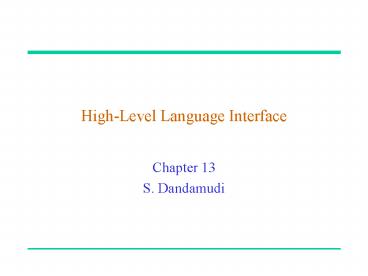High-Level Language Interface PowerPoint PPT Presentation
Title: High-Level Language Interface
1
High-Level Language Interface
- Chapter 13
- S. Dandamudi
2
High-Level Language Interface
- Why program in mixed-mode?
- Focus on C and assembly
- Overview of compiling mixed-mode programs
- Calling assembly procedures from C
- Parameter passing
- Returning values
- Preserving registers
- Publics and externals
- Examples
- Calling C functions from assembly
- Inline assembly code
3
Why Program in Mixed-Mode?
- Pros and cons of assembly language programming
- Advantages
- Access to hardware
- Time-efficiency
- Space-efficiency
- Problems
- Low productivity
- High maintenance cost
- Lack of portability
- As a result, some programs are written in
mixed-modem (e.g., system software)
4
Compiling Mixed-Mode Programs
- We use C and assembly mixed-mode programming
- Our emphasis is on the principles
- Can be generalized to any type of mixed-mode
programming - To compile
- bcc sample1.c sample.asm
5
Calling Assembly Procedures from C
- Parameter Passing
- Stack is used for parameter passing
- Two ways of pushing arguments onto the stack
- Left-to-right
- Most languages including Basic, Fortran, Pascal
use this method - These languages are called left-pusher languages
- Right-to-left
- C uses this method
- These languages are called right-pusher languages
6
Calling Assembly Procedures from C (contd)
- Example
- sum(a,b,c,d)
7
Calling Assembly Procedures from C (contd)
- Returning Values
- Registers are used to return values
- Return value type Register used
- char, short, int AX
- (signed/unsigned)
- long DXAX
- (signed/unsigned)
- near pointer AX
- far pointer DXAX
8
Calling Assembly Procedures from C (contd)
- Preserving Registers
- The following registers must be preserved
- BP, SP, CS, DS, SS
- In addition, if register variables are enabled,
- SI and DI
- should also be preserved.
- Since we never know whether register variables
are enabled or not, it is a good practice to
preserve - BP, SP, CS, DS, SS, SI and DI
9
Calling Assembly Procedures from C (contd)
- Publics and External
- Mixed-mode programming involves at least two
program modules - One C module and one assembly module
- We have to declare those functions and procedures
that are not defined in the same module as
external - extern in c
- extrn in assembly
- Those procedures that are accessed by another
modules as public
10
Calling Assembly Procedures from C (contd)
- Underscores
- In C, all external labels start with an
underscore - C and C compilers automatically append the
required underscore on all external functions and
variables - You must make sure that all assembly references
to C functions and variables begin with
underscores - Also, you should begin all assembly functions and
variables that are made public and referenced by
C code with underscores
11
Calling C Functions from Assembly
- Stack is used to pass parameters (as in our
previous discussion) - Similar mechanism is used to pass parameters and
to return values - C makes the calling procedure responsible for
clearing the stack of the parameters - Make sure to clear the parameters after the call
instruction as in - add SP,4
- on line 45 in the example program
12
Inline Assembly Code
- Assembly language statements are embedded into
the C code - Separate assembly module is not necessary
- Assembly statements are identified by placing the
keyword asm - asm xor AX,AX mov AL,DH
- We can use braces to compound several assembly
statements - asm
- xor AX,AX
- mov AL,DH
13
Inline Assembly Code (contd)
- Example
- Get date interrupt service
- Uses interrupt 21H service
- Details
- Input
- AH 2AH
- Returns
- AL day of the week (0Sun, 1Mon,)
- CX year (1980 - 2099)
- DH month (1Jan, 2Feb, )
- DL day of the month (1-31)
14
Inline Assembly Code (contd)
- Compiling inline Assembly Programs
- TASM method
- Convert C code into assembly language and then
invoke TASM to produce .OBJ file - Can use -B compiler option to generate assembly
file - Alternatively, can include
- pragma inline
- at the beginning of the C file to instruct the
compiler to use the -B option - BASM method
- Uses the built-in assembler (BASM) to assemble
asm statements - Restricted to 16-bit instructions (i.e., cannot
use 486 or Pentium instructions)
15
Inline Assembly Code (contd)
Last slide

